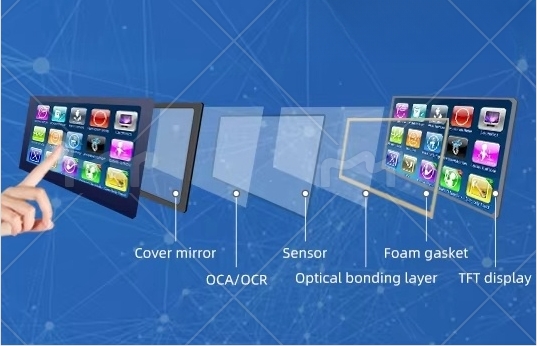Capacitive Touch Displays are a type of touchscreen technology widely used in smartphones, tablets, kiosks, and many other devices. They detect touch input through the electrical properties of the human body and are known for their high sensitivity, accuracy, and durability. Capacitive touchscreens are the go-to option for most modern touch-enabled devices because they offer a seamless, responsive user experience.

Key Features of Capacitive Touch Displays:
High Sensitivity and Accuracy Capacitive touchscreens detect touch through changes in the electrical charge of the screen, allowing for highly accurate and responsive touch input. The display detects the electrical field when a finger or conductive object touches the screen, enabling precise gestures like swiping, pinching, or tapping.
Multi-Touch Support Capacitive touchscreens support multi-touch, meaning they can detect and respond to multiple points of contact simultaneously. This is crucial for gestures like pinch-to-zoom, rotating, or other advanced interactions. Most modern capacitive displays can handle 5 to 10 touch points at once, allowing for smooth multi-finger gestures.
Durability and Scratch Resistance Capacitive touchscreens are often made with hardened glass (like Corning’s Gorilla Glass) to increase their durability and scratch resistance. They are more resistant to scratches and wear compared to resistive touchscreens. The surface is typically very smooth, providing excellent tactile feedback while being resistant to physical damage.
Clarity and Brightness Capacitive displays offer excellent clarity and brightness due to their design. Because they don’t require a layer of plastic film to detect touch, they allow for a clearer view and higher brightness, resulting in vivid images and sharp text. This makes capacitive displays ideal for high-resolution screens, where visual quality is paramount.
Smooth Touch Experience Capacitive touchscreens provide a smooth and fluid touch experience. The screen doesn't need to be pressed hard, and users only need to lightly touch the screen with a finger or conductive stylus for it to register. This provides a more natural and enjoyable user experience compared to resistive touchscreens that require pressure to register a touch.
No Mechanical Parts (Durability) Unlike resistive touchscreens that rely on pressure-sensitive layers, capacitive touchscreens have no moving mechanical parts. This means they are more durable and reliable over time, as they do not suffer from wear and tear caused by pressing or tapping repeatedly.
Multi-Layer Construction Capacitive touchscreens are often made up of multiple layers:
1. Conductive Layer: The screen’s surface is coated with a conductive material (usually indium tin oxide or ITO), which reacts to the electrical properties of the human body.
2. Insulating Substrate: Below the conductive layer, an insulating substrate protects the sensitive touch surface.
3. Glass or Plastic Layer: The final layer is a tough glass or plastic cover that gives the screen its structural integrity and protects the other layers.
Excellent Outdoor Visibility Capacitive touchscreens have good visibility in bright light conditions (like direct sunlight) compared to some other touchscreen technologies. The transmissivity of capacitive touch displays—how well they transmit light—helps maintain good visibility in harsh lighting.
Resistant to Environmental Factors Capacitive touchscreens are less affected by environmental factors such as dust, water, and moisture compared to resistive screens. They can still work in many wet or dusty environments as long as the touch is made by a human finger or a conductive stylus.
Uses Electrostatic Field Capacitive touchscreens operate based on electrostatic fields—when a finger touches the screen, it alters the screen's electrostatic field, allowing the system to detect the touch. This means capacitive touchscreens can’t be activated by regular styluses or gloved hands, unless they are designed to work with a special stylus or are glove-compatible models.
Faster Response Time Capacitive touchscreens have a faster response time compared to older technologies like resistive touchscreens. This means they can register inputs and respond more quickly, leading to smoother interactions and a better overall user experience, especially for tasks that require fast, continuous input.
No Calibration Required Unlike resistive touchscreens, capacitive touchscreens don't need to be calibrated after installation. They are plug-and-play, as the system detects the touch automatically without needing any adjustment. This ease of use is one reason capacitive touchscreens are favored in consumer electronics.
Types of Capacitive Touch Displays:
Projected Capacitive Touch (PCT) The most common type of capacitive touch technology used in smartphones, tablets, and other consumer electronics. Projected capacitive touchscreens use a grid of electrodes, typically arranged in a matrix, and detect touch based on changes in the electrostatic field. These are highly responsive, support multi-touch, and are widely used in modern touch-based devices.
Surface Capacitive Touch A less commonly used technology where a conductive layer is placed on the surface of the screen. When you touch the screen, it changes the electrical field at that point. While this technology is accurate and responsive, it typically supports fewer touch points than projected capacitive systems and doesn’t offer the same level of durability.
Mutual Capacitive vs. Self-Capacitive
1. Self-Capacitive: Detects the touch of a single point by measuring the capacitance change at one point of the screen. Typically found in smaller screens and used for simpler applications.
2. Mutual Capacitive: Uses a grid of electrodes to detect touch at multiple points. This technology allows for multi-touch functionality, making it suitable for modern smartphones and larger screens.
Applications of Capacitive Touch Displays:

Smartphones and Tablets Capacitive touch technology is the standard for smartphones and tablets. The ability to handle multi-touch gestures and the responsiveness of capacitive screens make them the go-to choice for mobile devices.
Laptops and Computers Many modern laptops, especially 2-in-1 convertible models, use capacitive touchscreens to support touch-based navigation. These devices allow for traditional laptop use, along with the versatility of touch input when in tablet mode.
Kiosks and Public Displays Capacitive touchscreens are widely used in interactive kiosks, ATMs, vending machines, and public signage due to their durability, easy-to-clean surfaces, and resistance to environmental factors.
Automotive Interfaces Many modern vehicles feature capacitive touch displays in infotainment systems, dashboards, and climate controls. The smooth and responsive nature of capacitive touch is ideal for automotive applications.
Wearables Capacitive touch is commonly used in smartwatches and other wearable devices. The technology allows for responsive, low-profile touch interfaces that are perfect for small screens.
Industrial Control Panels Capacitive touch technology is increasingly used in industrial applications such as machinery control panels, where users require intuitive and durable touch interfaces to operate equipment.
Home Appliances High-end home appliances like smart refrigerators, ovens, and washing machines often feature capacitive touch interfaces, offering a sleek and user-friendly way to control settings.
Medical Devices In medical equipment such as patient monitoring systems, capacitive touchscreens are used for their precise touch input and high durability, which is important in environments that demand high performance and hygiene.
Gaming and Entertainment Capacitive touch is also used in handheld gaming consoles, interactive displays in museums or theme parks, and other entertainment-focused applications due to its responsiveness and multi-touch capability.
Conclusion:
Capacitive touch displays provide a modern, highly responsive, and durable solution for a wide variety of applications, from mobile devices to industrial systems. Their smooth user experience, multi-touch capabilities, and resilience to environmental factors make them the dominant touchscreen technology in today's market.
Capacitive Touch Displays,standard type and customization
